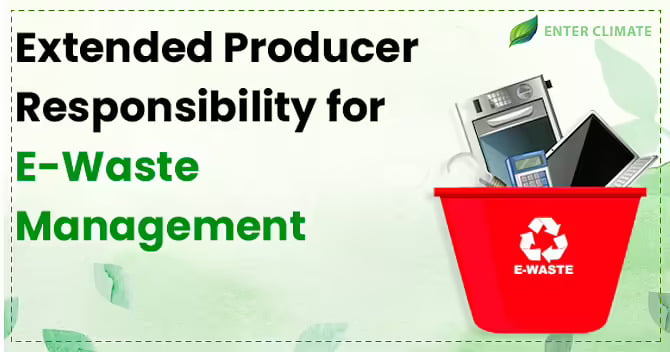Responsibilities of Importers under E-Waste Management Rules, 2016
 31 Aug, 2022
31 Aug, 2022 
The E-Waste Management Rules aim to regulate persons and entities involved in the manufacture, sale, transfer, purchase, collection, storage and processing of end-of-life Electrical and Electronic Equipment (EEE). Importers of EEE trade in new and used EEE by importing such products into the country. The rules governing import do not differentiate between new and used EEE. However, imported EEE are subject to many additional restrictions and post compliances. The import of used EEE and spares in whole or in part discarded as waste or rejected from manufacturing has a great demand in India’s recycling and refurbishment market. High-end used laptops, phones, AC, and scientific and lab equipment have a great demand in the country. It must be noted that importing e-waste for disposal is banned in India. But one can import used EEE for reuse, recycling and refurbishment. In the following article, we will see the responsibilities of importers under E-waste management Rules, 2016 and the different rules applicable to them in case of import of used or new EEE.
Rules governing the import of Used EEE into India
Along with the increasing demand for imported electronic products, the market for used and refurbished EEE in India has been on the rise, too, as many refurbished and repaired items (aka second-hand electronics) provide good value for the money with high-end specs. The E-Waste Management Rules, 2016 state that the import of EEE is allowed only to producers, importers and Brand Owners (PIBOs) having EPR authorisation. The Hazardous Waste Rules, 2016 also prohibit the import of e-waste for disposal in India. So, importing EEE that qualifies for import remains a grey area as there has not been a defined procedural way to classify a product as second-hand or non-functional. Import procedure, therefore, becomes challenging for importers as authorities have strict rules to classify such products so that e-waste does not enter the country disguised as refurbished or second-hand EEE. To keep a check on importers, specific rules have been instituted from time to time. Apart from the provisions of e-waste management under EPR, the responsibilities of importers of EEE (new/refurbished) in India include
- Spares imported for warranty replacements provided an equal number of defective/non-functional parts are exported back within one year of the import.
- Existing laws allow the import of second-hand products for repair or refurbishing under some conditions. The responsibility of importers will be to re-export it to the country of origin within 1-3 years after refurbishment. Used electrical & electronic assemblies imported for repair must be re-exported after repair within one year of import, while used electrical and electronic assemblies imported for testing, research and development, and project work purposes and to be re-exported back within three years from the date of import.
- Then we have the Customs Tariff Act that allows for new computers to be imported into India for free but does not mention anything about used computers.
- India’s EXIM (export-import) policy allows importing second-hand computers not more than ten years old.
- Under the Foreign Trade Act of 1992[1], the donation of computers from zones that have been set up primarily for export at zero customs duty is permissible.
Classification of EEE that can be imported
Under the E-Waste (Management) Rules, 2016, twenty-one types of electrical and electronic equipment have been notified, which at the end of their life become e-waste. They are as follows.
Category 1: Information technology and telecommunication equipment like Personal computers, centralised data processing, laptops, printers, photocopy machines, mobiles etc.
Category 2: Consumer electrical and electronics like Television sets, refrigerators, washing machines, ACs etc.
Responsibilities ofImporters
Responsibilities when importing new EEE: The importers must apply for Extended Producer Responsibility (EPR) Authorisation and comply with the RoHS provisions governing the imported product. Imports or placement of new EEE will be permitted only for those importers who comply with requirements of sub-rule (1) and sub-rule (4) of rule 16 of the E-Waste Management Rules, 2016.
Responsibilities of Importers while importing used EEE: In this case, the importers will have to apply for EPR Authorisation. The primary responsibilities of importers under E-Waste Management Rules, 2016 include
- They will be liable for all damages caused to the environment or third parties due to improper handling and management of the e-waste.
- They will be subject to pay financial penalties for any violation of these rules, which can be levied by the SPCB with prior approval from CPCB.
- They must maintain a record of imported products or e-waste and make it available to the CPCB or the concerned SPCB when demanded.
Licences and Authorisation Needed for EEE Import
EPR Authorisation: Under the additional responsibilities of importers of EEE, they have to obtain EPR Authorisation from the CPCB after submitting an EPR action Plan to the Board. It is now one of the responsibilities of importers to ensure a targeted collection of e-waste generated by the products they import into the country.
Importer -Exporter Code: IEC is a crucial business identification number that importers require to import products to India. No export or import can be done without obtaining an IEC unless exempted explicitly by DGFT.
BIS/ CRS Registration: For the import of electronics items (new as well as second hand, whether or not refurbished, repaired, reconditioned) notified under the “Electronics and Information Technology Goods (Requirement of Compulsory Registration) Order, 2012, the product must be registered with the Bureau of Indian Standards (BIS) and comply to the ‘Labelling Requirements’ mandated by BIS.
Additional Licencing and Compliance responsibilities of Importers
- Business Registration
- GST Registration
- WPC Approval (depending on the product)
- TEC Certification (depending on the product)
Documents Needed
Depending upon the licence, any or all of the documents will be required
- Address Proof
- Copy of GST
- Product Details, including Model Numbers and Production / Import History
- RoHS Certificate (including self-declaration for conformity RoHS provision)
- Estimated generation of e-waste item-wise and estimated collection target for the forthcoming year (for EPR)
- Copies of agreement with Dealers, Collection Centre, Recyclers, Treatment, Storage and Disposal Facility, etc. (for EPR)
DocumentsRequired when importing EEE for Repair/Refurbishment.
- Duly filled up Form 6 that relates to the movement document
- Undertaking for re-export to fix the responsibilities of Importersbefore importing the item.
- Details of import done previously, if there has been any and confirmation regarding their re-export
- A copy of the annual return filed with the concerned SPCB for import in the last financial year.
- Certificate from exporting party for accepting all repaired and unrepairable electrical and electronic assemblies and the spares, parts, components, or consumables being re-exported.
- Proof of export of the defective EEE (like shipping or airway document authenticated by Customs)
- Chartered Engineer Certificate or certificate from the accredited agency of exporting country indicating the functionality, manufacturing date, residual life and serial number;
- If refurbished components are being imported as a replacement for defective components, then undertaking for export of equivalent numbers of faulty parts.
- One of the additional responsibilities of Importers will be to declare their policy regarding using second-hand or refurbished spare parts to repair electrical and electronic assemblies during the warranty period.
Conclusion
There is a vast market for new and second-hand EEE in the country. The imported electronic goods can fulfil this demand and lessen the manufacturing and, therefore, the consumption of valuable resources. The import of refurbished and usedEEE is beneficial for India, which depends on several countries for the import of components and metals that are critical to the manufacturing of EEE. The case with the import of electronic and electrical equipment is complex compared to other items; therefore, the importers’ responsibilities also differ accordingly. This can require qualified opinion and assistance from experts in the field. Assistance and guidance in the import business will not only simplify the procedure of obtaining import licences and permits but can also open doors for subsequent business opportunities.
Read our Article:Extended Producer Responsibility for E-Waste Management













